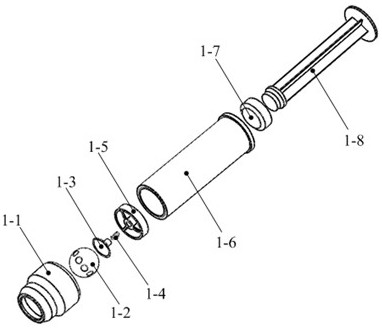A robot terminal drug applicator for skin disease treatment
A skin disease and robot technology, applied in the field of medical devices, can solve problems such as threats to the health of auxiliary drug applicators, secondary skin damage to patients, and effects on drug treatment effects
- Summary
- Abstract
- Description
- Claims
- Application Information
AI Technical Summary
Problems solved by technology
Method used
Image
Examples
specific Embodiment approach
[0027] Step 1: Localization of the affected area of the robot
[0028] This step is an introduction to the use conditions of the present invention: install a robot terminal drug applicator for skin disease treatment of the present invention on the end of the positioning robot, and position the terminal drug applicator on the skin patient's skin through visual recognition of the robot. sick place;
[0029] Step 2: Clean the affected area
[0030] Start the horizontal plate drive motor I7-3 and the horizontal plate drive motor II7-5 on the same side as the cleaning module 5, and the rotation of the motor makes the horizontal plate drive motor I7-3, the horizontal plate drive motor II7-5, the cleaning module 5 and the temperature adjustment The parallelogram formed by the massage module 6 is deformed, so that the temperature-adjusting massage module 6 is on the top, and the cleaning module 5 is on the bottom. The cleaning cotton wool 5-3 contacts the skin of the affected area,...
PUM
 Login to View More
Login to View More Abstract
Description
Claims
Application Information
 Login to View More
Login to View More - R&D
- Intellectual Property
- Life Sciences
- Materials
- Tech Scout
- Unparalleled Data Quality
- Higher Quality Content
- 60% Fewer Hallucinations
Browse by: Latest US Patents, China's latest patents, Technical Efficacy Thesaurus, Application Domain, Technology Topic, Popular Technical Reports.
© 2025 PatSnap. All rights reserved.Legal|Privacy policy|Modern Slavery Act Transparency Statement|Sitemap|About US| Contact US: help@patsnap.com



